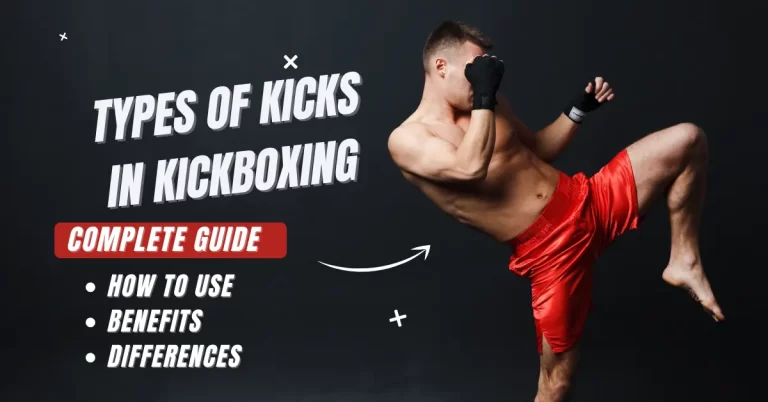6 Types of Kickboxing – What Are The Different Styles?
If you’re looking for a high-intensity workout that improves your self-defense skills, kickboxing might be just what you need. Kickboxing is a combat sport combining martial arts elements such as karate, boxing, and Muay Thai.
Here is a quick list of six different types of Kickboxing.
- American Kickboxing (Full-Contact)
- Japanese Kickboxing (K-1)
- Muay Thai Kickboxing
- Sanda Kickboxing
- Low Kick Kickboxing
- Fitness Kickboxing
In this article, we will explore the different types of kickboxing, their unique features, and which one is right for you.
General Introduction to Kickboxing
Kickboxing is a full-body workout that involves striking with punches, kicks, and knee strikes. It’s an effective cardio exercise that can help you burn calories, build strength and endurance, and improve your balance and coordination.
Kickboxing can also help relieve stress, boost your confidence, and teach self-defense techniques.
6 Different Types of Kickboxing

1. American Kickboxing (Full-Contact)
American Kickboxing, also known as Full-Contact Kickboxing, is a style of kickboxing that originated in the United States in the 1970s.
In this style, fighters wear gloves, and full body padding for protection, and strikes are limited to above the waist. The rules are similar to those of boxing, focusing on power and precision.

2. Japanese Kickboxing (K-1)
Japanese Kickboxing, also known as K-1, is a hybrid style of kickboxing that combines elements of traditional karate and Muay Thai.
In K-1, fighters can use various strikes, including kicks, punches, and knee and elbow strikes. The matches are typically held in a ring, and fighters cannot clinch or grapple.
3. Muay Thai Kickboxing
Muay Thai Kickboxing, also known as “the art of eight limbs,” is a traditional martial art from Thailand. It is a highly effective form of self-defense using punches, kicks, and elbow and knee strikes.
In Muay Thai, fighters wear gloves and shorts and can strike any part of the body above the waist. The matches are in a ring, and fighters can clinch, grapple and use sweeps to take down their opponents.
4. Sanda Kickboxing
Sanda Kickboxing, also known as “Sanshou”, is a style of kickboxing that originated in China.
In Sanda, fighters wear padded gloves, shin guards, and headgear; strikes are limited to above the waist.
The matches are held in a ring, and fighters can use throws, takedowns, and sweeps to take down their opponents. Sanda is a highly competitive sport that requires strength, agility, and quick reflexes.
5. Low Kick Kickboxing
Low Kick Kickboxing, also known as Dutch Kickboxing, is a style of kickboxing that originated in the Netherlands in the 1980s.
In this style, fighters are allowed to use low kicks, which target the legs of their opponents. Low Kick Kickboxing also includes many strikes, including punches, knee strikes, and high kicks. The matches are typically held in a ring, and fighters wear gloves and shorts.
6. Fitness Kickboxing
Fitness Kickboxing is a non-competitive form of kickboxing that is focused on fitness and weight loss.
In Fitness Kickboxing, the emphasis is on technique and form rather than sparring or competition. The classes are usually held in a group setting, and the workouts are designed to be fun, challenging, and high-energy.
What Type of Kickboxing is Most Dangerous?

All types of kickboxing are safe to play if players follow the rules. Like any combat sport, kickboxing can pose risks without proper care and technique. It’s important to find a good kickboxing trainer and practice safety measures to minimize the risk of injury.
However, kickboxing is a diverse and challenging workout that can benefit fitness, self-defense, and confidence.
With different styles and approaches, there’s a kickboxing style that can suit your goals and preferences. Whether a beginner or an experienced athlete, kickboxing can be a fun and rewarding way to improve your physical and mental health.
People Also Ask
Do I need to have prior martial arts experience to start kickboxing?
You don’t need any prior martial arts experience to start kickboxing. Many kickboxing gyms offer beginner classes designed for people with little experience.
How often should I train in kickboxing?
The frequency of kickboxing training can depend on your goals and fitness level. For beginners, it’s recommended to start with 1-2 classes per week and gradually increase the frequency as you improve.
Conclusion
Kickboxing is a highly effective exercise that can help you improve your fitness, self-defense skills, and confidence.
There are many different styles of kickboxing to choose from, each with its unique features and benefits.
Whether you’re looking to compete, improve your fitness, or learn self-defense, there’s a kickboxing style that can suit your goals and preferences. It’s important to note that while kickboxing can be a fun and challenging workout, it’s also a combat sport that can pose risks if not practiced with proper care and technique.
Before starting any kickboxing training, it’s important to consult with a doctor and find a qualified instructor who can guide you in proper technique and safety measures.






